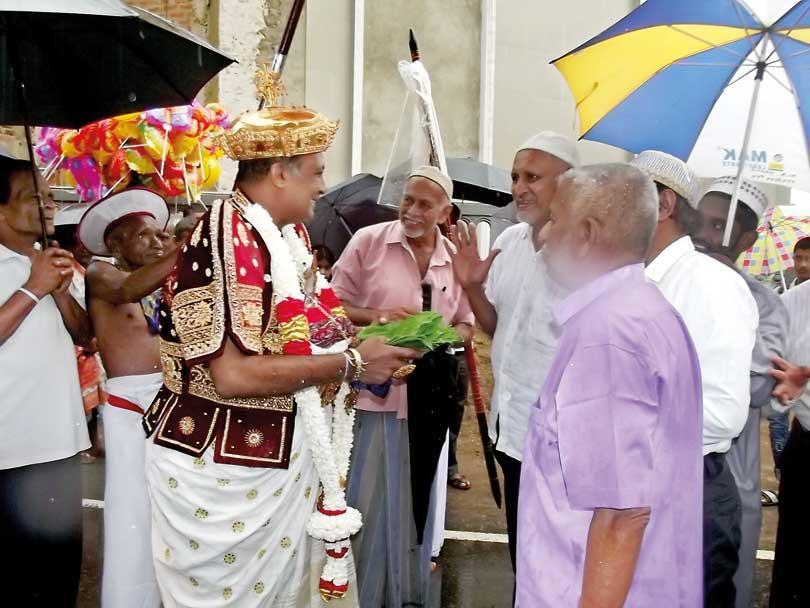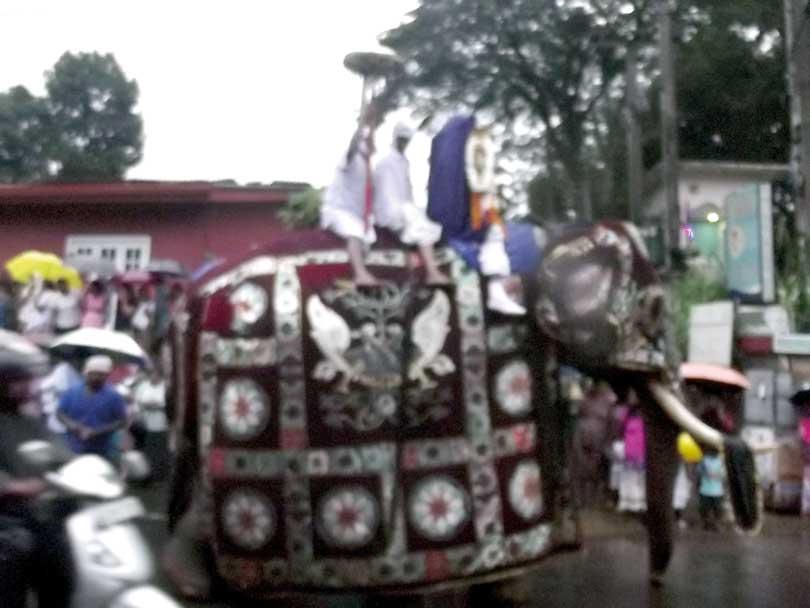Reply To:
Name - Reply Comment

 Though there were misunderstandings among the Sinhala and Muslim communities, yet the Muslims are trying to heal the differences. The Gampola Muslim community through their President Al-Haj Nazoor Deen welcomed the Basnayake Nilame of Walhagoda Devale Seevali Nugegoda on the last day of the Walhagoda Devale Perahera on Sunday with the sheaf of betel at Kahatapitiya Mosque entrance. Kahatapitya Mosque land has been gifted by Bhuveneka Bahu the IV when Mohammedans coming from Arabia wished to have some land for them to worship Adam’s Peak from Kahatapitya. Adam’s Peak can be seen from the present premises of Kahatapitiya.
Though there were misunderstandings among the Sinhala and Muslim communities, yet the Muslims are trying to heal the differences. The Gampola Muslim community through their President Al-Haj Nazoor Deen welcomed the Basnayake Nilame of Walhagoda Devale Seevali Nugegoda on the last day of the Walhagoda Devale Perahera on Sunday with the sheaf of betel at Kahatapitiya Mosque entrance. Kahatapitya Mosque land has been gifted by Bhuveneka Bahu the IV when Mohammedans coming from Arabia wished to have some land for them to worship Adam’s Peak from Kahatapitya. Adam’s Peak can be seen from the present premises of Kahatapitiya.
The Muslim community has forgotten the 1915 riots between the Sinhala and Coastal Muslims popularly known as “Hambayas” in a legal battle.
Hambayas were a section of Boras or coastal moors who were averse to this Perahera as they were the persons who built the mosque at Gampola and Kandy. The Ceylon Moors had integrated into the Sinhala community but in the riots most had blamed the ‘Muslims’ which should not be so.
of the main speakers for the Sinhala people at that time was Sir Ponnanbalam Ramanathan who did so in the Legislative Council. There had been a wide difference in the outlook of Coastal Moors and Ceylon Moors who had lived amicably for centuries in the country
The Muslim community has forgotten the 1915 riots between the Sinhala and Coastal Muslims popularly known as “Hambayas” in a legal battle
In fact, it was the coastal Muslims who built two Mosques, one in Gampola and one in Kandy in 1910. The one in Gampola stood on Ambagamuwa street and the other on the present Kotugodelle Veediya in Kandy. The Devale Perahera proceeds after the water cutting ceremony at Bothalapitiya around seven kilometres from the Devale property which lies on the Gampola-Nawalapitiya road and passes the mosque at Ambagamuwa road, built by the coastal moors.
The Coastal Muslims objected that the Devale Perahera which goes only on one day, after the ‘water cutting’ ceremony should not proceed to pass the mosques they built, by drumming and the music that goes with the Perahera.
The then Government Agent George Saxton sent out an order to Police that they fix notices that the Perahera should not proceed along Ambagamuwa street with music and elephants. The Government Agent also ordered that the Police inform the Basnayake of the order.
The Governor was Sir Robert Chalmers who himself was an oriental scholar. Yet, he allowed the Government Agent to act the way he wanted, little realizing that the Basnayake Nilame would go to Courts.

In 1963, the writer met the then Inspector General of Police Sir Herbert Dowbiggin in Ipswich at his home. In a conversation, the subject was the riots of Gampola. He said that the Government Agent had no right to order the police of Gampola, to put up the notices in the famous Gampola case. He said that the Government Agent had no right legally to order the Police except through him. But, he said that at that time he did not want to get involved as he understood that the Governor had made the Government Agent order the Police to put up notices. He added that the Police at that time was there to protect the Government of His Majesty at any cost and he just lied low in this case. In fact, he said that he did not even visit this town as the Government Agent was handling the issue with the Governor.
Coming back to the main issue, the Basnayake Nilame of Walhagoda Devale consulted the Diyawadana Nilame, Punchi Banda Nugawela and other Buddhists filed action in the Kandy District Court. The complaint was that the order by the Government Agent Saxton violates Clause five of the Kandyan Convention which guarantees the freedom of the Buddhists, on their rites, ministries and their worship.
District Judge Paul Pieris on 4th June 1915 made an order that the Walhagoda Esala Perahera was a rite of the religion and the order made by the Government violates the Kandyan Convention made between the Sovereign of Great Britain and the Kandyan Chiefs. The Perahera could go along including Ambagamuwa road with elephants and music.
The Attorney General Anton Bertram appealed against the order of the District judge.
The Supreme Court consisting of Justice Shaw and Justice Thomas de Sampayo reversed the order of the District Judge.
This infuriated the Buddhist and the Basnayake Nilame who in turn appealed against the order of the Supreme Court to Privy Council.
In a turn of events, Sir Robert Chalmers is said to have been recalled and Sir John Anderson replaced him. He had been in Sri Lanka earlier and this added with the chaos that has already sprung up he decided to intervene and though it was only a few days that he had stepped into the country, yet decided that he must see for himself the situation and talk matters over with the two groups - the Mohammadans and the Sinhala people.
The Coastal Muslims objected that the Devale Perahera which goes only on one day, after the ‘water cutting’ ceremony should not proceed to pass the mosques they built, by drumming and the music that goes with the Perahera
He brought about a settlement between the two parties after much damage had been done to both sides. Sir Chalmers was considered an Oriental scholar, yet he acted in a way detrimental to the Sinhala people and also seems to have taken his stand towards the Mohammedans, the Bora sect of Muslims. But underlying it was an International situation that he had to take a stand with the Mohammedans as Britain had to be saved in the International field.
However, another attack was done in Kurunegala by the same group of Mohammedans of Kandy, which tended the Governor to call the ‘ Punjabis from India to quell the riots and this created untold damage to all. Politicians were taken into custody and both sides suffered intensely.
Sir Anderson who had been in the Colonial Office, having studied the situation, not only settled it but made way for the Basnayake Nilame to be represented by an eminent lawyer in Britain and a Ceylonese lawyer to represent the case at the Privy Council, and inform them that the matter has been settled.
However, the Muslim community, headed by the President Al-Haj Nazoor Deen of Kahataptiya Gampola Jumma Mosque took the liberty to present a sheaf of Betel to the Basnayake Nilame Seevali Nugegoda and show that they are with the Sinhala Community and have no differences between them during the Perahera on Sunday, with the President of the Kahatapitiya Mosque Al Haj Nazoor Deen and Vice Presidents Al Haj Mazir, Al Haj M.M. Hariss and the Secretary S.M. Tharik.
To this there is an underlying story and that is when the late Member of Parliament Al-Hal Cader passed away, around two years ago and his body was lying at his home on Ambagamuwe street and that was on the day of the Perahera. The Basnayake Nilame Seevali Nugegoda, took liberty even without the knowledge of the Police to divert the Perahera to see that it did not pass his home. This may also have been the reason why the Muslim community has thought that all misunderstandings have now died down.